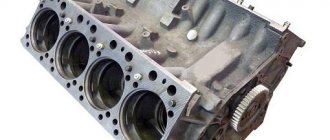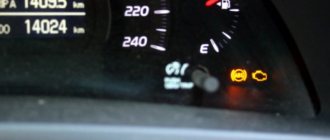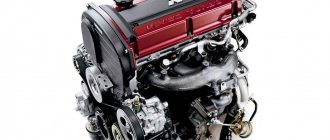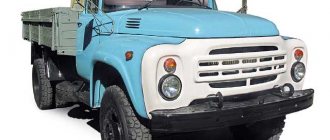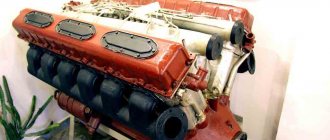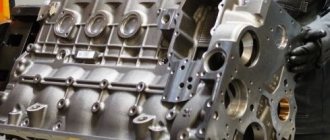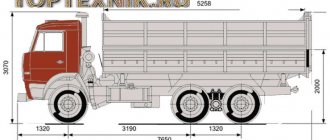General design of the KamAZ 740 and Euro series engine
Catalog and prices for KamAZ engines
KamAZ trucks began to be produced in 1969, for which engineers created a 4-stroke eight-cylinder diesel engine KamAZ-740 V8. This power unit had a working volume of 10852 cm3, and its power was 210 horsepower. Then the power ratings had to be expanded from 180 hp. up to 360. These trucks were equipped with a pneumatic clutch booster and a 5-speed gearbox with synchronizers.
Longitudinal section of a KamAZ engine
1 - generator; 2 — low pressure fuel pump; 3 — manual fuel priming pump; 4 — high pressure fuel pump; 5 — automatic fuel injection advance clutch; 6-half coupling driving the high pressure fuel pump; 7-connecting pipe for inlet air ducts; 8 — fine fuel filter; 9 — cam shaft; 10 - flywheel; 11 — flywheel housing; 12-drain plug; 13-engine crankcase; 14-crankshaft; 15 — oil pump; 16 — drive shaft of the leading part of the fluid coupling; 17 — generator drive pulley; 18-impeller fan
Cross section of the KamAZ-740 engine
1 — full-flow oil purification filter; 2 — oil filler neck; 3 - oil level indicator; 4 — centrifugal oil filter; 5 - thermostat box; 6 — front eye bolt; 7 - compressor; 8 - power steering pump; 9 — rear eye bolt; 10 — left water pipe; 11 — torch candle; 12- left intake air duct; 13 — nozzle; 14 — nozzle mounting bracket; 15 — exhaust manifold pipe; 16 — exhaust manifold
Design features of the KamAZ-740 engine
— pistons cast from a high-silicon aluminum alloy, with a cast-iron reinforcing insert under the upper compression ring and a colloidal-graphite running-in coating for the skirt; — cylinder liners, volumetrically hardened and treated with flat-top honing; — piston rings with chrome and molybdenum coating of the side surfaces; — three-layer thin-walled steel-bronze liners for main and connecting rod bearings; — a closed cooling system filled with low-freezing coolant, with automatic temperature control, a fluid coupling for the fan drive and thermostats; — highly efficient filtration of oil, fuel and air using paper filter elements; — electric torch air heating device, which ensures reliable engine starting at negative ambient temperatures down to minus 25 C.
The cylinder block is cast from alloy gray cast iron integral with the upper part of the crankcase. The crankcase part of the block is connected to the main bearing covers with transverse tie bolts, which gives strength to the structure. To increase longitudinal rigidity, the outer walls of the block are made curved. The bosses of the cylinder head bolts are bosses on the transverse walls that form the water jacket of the block.
The left row of cylinders is shifted forward relative to the right by 29.5 mm, which is caused by the installation of two connecting rods on one crank pin of the crankshaft.
A cover is attached to the front of the block that covers the hydraulic coupling of the fan drive, and at the back there is a flywheel housing, which serves as a cover for the accessory drive mechanism located at the rear end of the block.
Wet-type cylinder liners are easily removable, made of special cast iron, volumetrically hardened to increase wear resistance.
The liner mirror is processed by flat-top honing to obtain a grid of depressions and areas at an angle to the liner axis. This treatment helps retain oil in the depressions and improve the running-in of the liner.
In the connection between the liner and the cylinder block, the water cavity is sealed with rubber O-rings. In the upper part there is a ring installed under the collar in the bore of the liner, in the lower part two rings are installed in the bores of the block.
Cylinder block
It is the housing of the unit, intended for mounting and securing all motor mechanisms. The cylinder block is made in the form of a monolithic cast structure. The part has technological holes, as well as channels for lubrication and cooling.
In the upper part of this block there are sockets for sleeves. The housing is equipped with channels and cavities for the passage of coolant. A crankshaft is installed at the bottom of the block. The crankcase has two technological holes for lubrication. Inside the unit has partitions with special stiffening ribs. Special bores are made in these partitions and crankcase walls, which are closed with lids. These parts serve as supports for the crankshaft.
The liners serve as guides for the pistons. Together with the block head, they form a special cavity, which is the fuel combustion chamber. The sleeves are made of special cast iron and are also electrically hardened.
KamAZ engine cylinder head
Each head has a cooling jacket inside, which in turn is connected to the block jacket. Also, each head has lubrication holes, valves for inlet and outlet, and a special socket for the nozzle.
Each KamAZ block head is installed on two locating pins pressed into the cylinder block and secured with four alloy steel bolts. One of the locating pins also serves as a bushing for supplying oil to lubricate the valve rocker arms. The bushing is sealed with rubber rings.
Engine crankshaft
The crankshaft is made of high-quality steel and has five main and four connecting rod journals, hardened by high-frequency heat, which are interconnected by cheeks and mated to them with transition fillets.
For uniform alternation of working strokes, the location of the crankpins of the crankshaft is made at an angle of 90°. Two connecting rods are attached to each connecting rod journal of the KamAZ crankshaft: one for the right and one for the left rows of cylinders.
To balance inertial forces and reduce vibrations, the Kamaz crankshaft has six counterweights, stamped integrally with the crankshaft cheeks. In addition to the main counterweights, there are two additional removable counterweights 1 and 2, pressed onto the shaft, and their angular position relative to the crankshaft is determined by keys 5 and 6. A ball bearing is pressed into the bore of the crankshaft shank.
Lubrication system design
The engine is equipped with a combined type lubrication system. Depending on where the rubbing parts are located and under what conditions they operate, oil is supplied in different ways. The system can spray, supply oil under low pressure, or let it flow by gravity. The device supplies oil under pressure to parts that are more susceptible to wear and work in especially loaded units. This unit consists of main instruments and devices in which lubricant is stored, filtration and supply devices, as well as oil cooling. The oil passes from the pan to the oil receiver and passes through a special filter in the form of a mesh. It then goes to the oil pump. From the injection section, through a special channel, lubricant is supplied to the oil filter, and then to the lines. Next, the cylinder head and cylinder block are lubricated through the lubrication channels under pressure, and then to other components, such as the crankshaft, gas distribution mechanism, compressor and fuel pump.
In the cylinders, excess lubricant is removed using oil scraper rings, and then goes further through the piston grooves. This lubricates the piston pin support in the upper head. From the main line, oil is supplied to the thermal power sensor. If the valve that turns on the fluid coupling is open, then the coupling is also processed. If it is in the closed position, then liquid is supplied from the centrifugal filters into the pan. If there is not enough lubrication, then power decreases, parts also suffer increased wear, the motor overheats, bearings melt, and pistons can seize.
Supply system
The KamAZ engine is equipped with a separating type power unit. The injection pump and injectors are separated here. The fuel system consists of diesel fuel storage tanks, fuel filters, a low-pressure pump, high-pressure fuel pump, and fuel lines.
From the fuel tanks, fuel passes through a booster pump to the cleaning filters. Then, through a network of low-pressure fuel lines, diesel fuel is supplied to the injection pump. After the injection pump pumps diesel under high pressure in portions, based on the operating modes of the engine, through injectors into the cylinders and combustion chambers. The nozzles, in turn, spray the mixture. Excess diesel fuel returns to the tank through a bypass valve.
Cooling system
Cooling is implemented in the form of a closed system with a liquid cooler and forced circulation.
The coolant circulates under the influence of a centrifugal pump. First, antifreeze enters the cavity of the left row of cylinders, then through the tube into the right cavity. Then the mixture washes the cylinder liners, and then through the holes - the cylinder head cavity.
The hot coolant then goes to the thermostats, and then either to the radiator or to the water pump. Temperature conditions are regulated by thermostats and fluid couplings.
Pistons and connecting rods
The Kamaz-740 connecting rod is steel, forged, the rod has an I-section. The upper head of the connecting rod is one-piece, the lower one is made with a straight and flat connector. The connecting rod is finally processed together with the cap, so the connecting rod caps are not interchangeable. A steel-bronze bushing is pressed into the upper head of the Kamaz-740 connecting rod, and replaceable liners are installed into the lower one.
The cover of the lower head of the Kamaz-740 connecting rod is secured with nuts screwed onto bolts previously pressed into the connecting rod rod. On the cover and rod of the connecting rod there are pairing marks - three-digit serial numbers. In addition, the cylinder serial number is stamped on the connecting rod cover.
KamAZ piston
cast from aluminum alloy with a wear-resistant cast iron insert under the upper compression ring. The side surface is a complex oval-barrel shape with a reduction in the area of the holes for the piston pin. The skirt has a graphite coating. Kamaz pistons are equipped with three rings, two compression and one oil scraper. Its distinctive feature is the reduced distance from the bottom to the lower end of the upper groove, which is 17 mm.
The pistons of engines 740.11, 740.13 and 740.14 differ from each other in the shape of the grooves for the upper compression and oil scraper rings. Installation of pistons from Kamaz 740.10 and 7403.10 engines is unacceptable. It is allowed to install pistons with piston rings of engines 740.13 and 740.14 on engine 740.11.
Kamaz compression rings are made of high-strength, and oil scraper rings are made of gray cast iron. On the 740.11 engine, the cross-sectional shape of the compression rings is one-sided trapezoid; during installation, the inclined end should be located on the side of the piston bottom.
The design of the KamAZ Euro-1 engine
A new piston group appeared and all elements of the new one underwent changes. At the same time, the mass of the unit increased from 760 to 835 kg. Differences appeared in the cylinder blocks. The cross-section of the oil channel has increased, and the installation locations of some components and mechanisms have been moved. The Euro 1 equipment has been replenished with nozzles for cooling the piston. Now the pusher guides are attached to the block. Efficiency has improved compared to the basic version.
The design of the KamAZ Euro-2 engine
Power units of the 740.31 series began to be produced with the Euro-2 standard. Here, turbocharging with intermediate cooling of the supplied air was used. Power remained the same - 240 hp. with a volume of 10.85 liters. The design differs from the previous version in the presence of a heat exchanger and intercooler. Instead of a fluid coupling, a more modern electromagnetic coupling is already used, and a new pump and belts have also been installed.
Catalog and prices for KamAZ engines
Unstable operation, knocking, smoke
If the power unit vibrates strongly, and this can be with a warm or cold engine, idling or under load, then in this case several systems need to be checked. Firstly, the injection valves of the injection pump may be faulty or the injectors may be acting up. If the crankshaft was replaced before, then most likely there is a problem with its balancing.
The most common cause of knocking is oil starvation of the internal combustion engine. This can happen not only due to an insufficient amount of lubricant in the system, but also due to poor quality of the lubricant. In this case, the crankshaft usually jams and the liners rotate. As for smoke, it often appears due to a broken cylinder head gasket. White exhaust at sub-zero temperatures on a cold internal combustion engine is normal. In general, the KamAZ Euro-2 engine, the photo of which you can see, requires regular replacement of the air filter. If it is clogged, black smoke may appear.
Types of motors
Despite the same operating principle, the KAMAZ 740 engine lineup has undergone significant changes. Models with more or less power for different cars were developed, reliability, maximum mileage were increased and fuel costs were reduced. Filters were added that made the actual need for maintenance more frequent and made it possible to increase the environmental standard of the motor.
Euro 0 motors marked 740.210 and 740.260
| 740.210 | 740.260 | |
| power, kWt | 154 | 191 |
| Fuel volume, l | 10,85 | 10,85 |
| Oil volume, l. | 26 | 28 |
| Fuel compression | 17 | 16,5 |
| Weight, kg. | 750 | 780 |
| Specific fuel consumption | 155 | 207 |
Euro 2 motors marked 740 31 240 and 740 30 260
| 740.31.240 | 740.30.260 | |
| power, kWt | 176 | 191 |
| Fuel volume, l | 10,85 | 10,85 |
| Oil volume, l. | 26 | 28 |
| Fuel compression | 16 | 16,5 |
| Weight, kg. | 760 | 885 |
Euro 2 motors marked 740 51 320 and 740 50 360
| 740.51.320 | 740.50.360 | |
| power, kWt | 176 | 191 |
| Fuel volume, l | 10,85 | 10,85 |
| Oil volume, l. | 26 | 28 |
| Fuel compression | 16 | 16,5 |
| Weight, kg. | 760 | 885 |
| Specific fuel consumption | 207 | 207 |
Euro 4 motors marked 740 70 and modifications
| 740.70._____ | |
| power, kWt | 280-440 |
| Fuel volume, l | 11,76 |
| Oil volume, l. | 28-32 |
| Fuel compression | 16,8 |
| Weight, kg. | 870 |
During the improvement of the engine range, a colossal amount of work was carried out. In addition to meeting the Euro-4 environmental standard, the new engines have increased their service life several times, as well as reduced fuel consumption by 9% and reduced natural oil loss.
Maintenance
Motor maintenance is a fairly simple procedure. It involves replacing the lubricant and coolant. The operating documentation for the device states that maintenance must be carried out on average after 15,000 kilometers. Practice shows that for new power units this figure can be safely increased to 20,000 by visually and auditorily monitoring the condition of the engine.
In addition to changing oils and fluids, experts recommend flushing the fuel system and adjusting the engine valves. These procedures improve engine performance and also make it possible to increase the vehicle's mileage before overhaul by 100,000 kilometers.
Coolant replacement
Timely inspection of the engine cooling system is one of the keys to stable engine operation. It should not be carried out as planned, but every day before departure. This is done through a visual inspection of the system for depressurization and replenishment of fluid.
The fluid should be changed if the antifreeze is contaminated or loses its basic properties. However, most often the replacement is carried out when the season changes: in the summer the cooling system of the KamAZ 720 engine can be filled with simple purified water, in the winter the radiator is filled with a special coolant (antifreeze, antifreeze). Under no circumstances should you mix antifreezes with different compositions; this can cause a reaction and reduce performance or even clog the cooling system.
The fluid replacement procedure is performed in the following sequence:
- Antifreeze drain. To do this, open the taps under the radiator, heat exchanger and pump, expansion tank and supply pipes for air flow.
- Flush the system with water if another substance is added.
- Close all taps and fill in new fluid through the expansion tank.
When choosing antifreeze, you should pay attention to the composition and performance characteristics. In addition to replacing antifreeze, servicing the engine cooling system includes:
- washing and lubricating the water pump;
- pressure testing of the cooling system in search of leaks;
- flushing of communications;
- inspection of fluid level and quality.
Change of oil
Maintenance of the engine lubrication system is another necessary condition for the long operation of the car’s power unit. Cleaning the system and changing the oil should be carried out every 10 - 15 thousand kilometers. Before you begin , you need to clarify how many liters of oil are needed for a KamAZ engine.
The KamAZ 740 engine lubrication system is no different from most other engines, so the replacement procedure looks pretty standard:
- unscrew the plug and drain the used oil;
- remove and clean the filter;
- clean the centrifuge;
- install the parts in place, replacing the gaskets;
- add new oil.
It is necessary to constantly monitor the lubricating fluid level. It should always be in the area of mark B. This ensures optimal oil pressure in the system.
